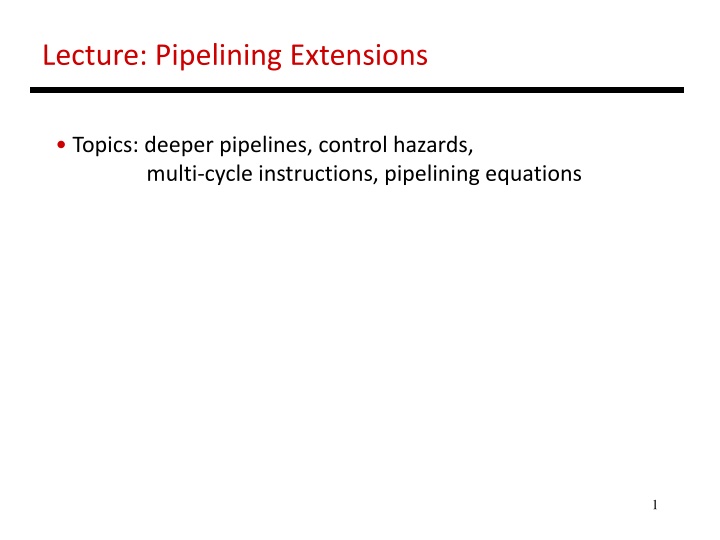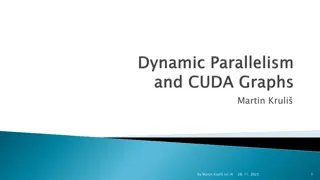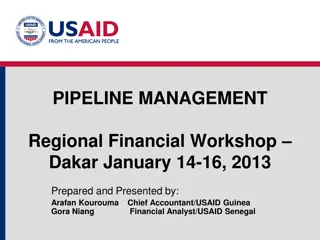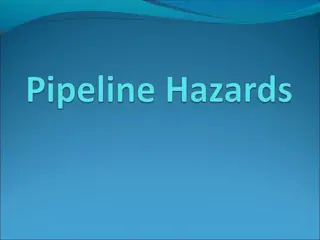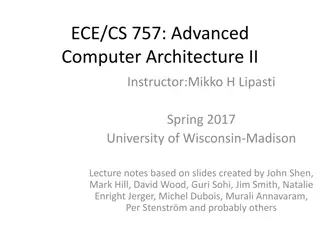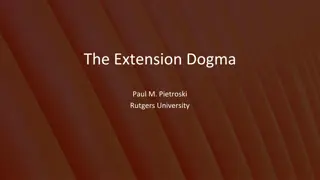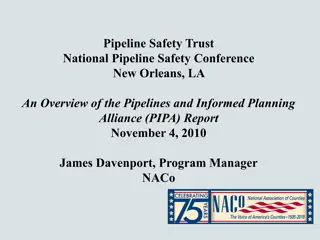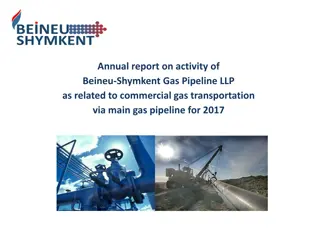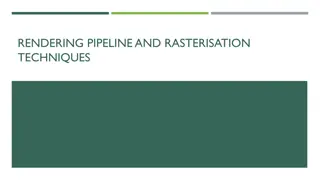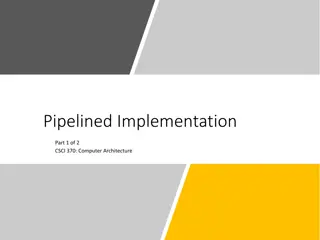Advanced Pipeline Extensions in Instruction Level Parallelism
Delve into deeper pipelines, control hazards, multi-cycle instructions, and pipelining equations in advanced pipeline extensions. Analyze instruction stages with bypassing, identify input latches, and explore optimizations like bypassing and stalling.
Download Presentation

Please find below an Image/Link to download the presentation.
The content on the website is provided AS IS for your information and personal use only. It may not be sold, licensed, or shared on other websites without obtaining consent from the author.If you encounter any issues during the download, it is possible that the publisher has removed the file from their server.
You are allowed to download the files provided on this website for personal or commercial use, subject to the condition that they are used lawfully. All files are the property of their respective owners.
The content on the website is provided AS IS for your information and personal use only. It may not be sold, licensed, or shared on other websites without obtaining consent from the author.
E N D
Presentation Transcript
Lecture: Pipelining Extensions Topics: deeper pipelines, control hazards, multi-cycle instructions, pipelining equations 1
Problem 6 Show the instruction occupying each stage in each cycle (with bypassing) if I1 is R1+R2 R3 and I2 is R3+R4 R5 and I3 is R3+R8 R9. Identify the input latch for each input operand. CYC-1 CYC-2 CYC-3 CYC-4 CYC-5 CYC-6 CYC-7 CYC-8 IF I1 IF I2 IF I3 IF I4 IF I5 IF IF IF D/R D/R I1 D/R I2 L3 L3 L4 L3 L5 L3 D/R I3 D/R I4 D/R D/R D/R ALU ALU ALU I1 ALU I2 ALU I3 ALU ALU ALU DM DM DM DM I1 DM I2 DM I3 DM DM RW RW RW RW RW I1 RW I2 RW I3 RW
Pipeline Implementation Signals for the muxes have to be generated some of this can happen during ID Need look-up tables in decode stage to identify situations that merit bypassing/stalling the number of inputs to the muxes goes up 3
Problem 7 For the 5-stage pipeline (RR and RW take half a cycle) D/ RR IF AL DM RW For the following pairs of instructions, how many stalls will the 2nd instruction experience (with and without bypassing)? ADD R3 R1+R2 ADD R5 R3+R4 LD R2 [R1] ADD R4 R2+R3 LD R2 [R1] SD R3 [R2] LD R2 [R1] SD R2 [R3] 4
Problem 7 For the 5-stage pipeline (RR and RW take half a cycle) D/ RR IF AL DM RW For the following pairs of instructions, how many stalls will the 2nd instruction experience (with and without bypassing)? ADD R3 R1+R2 ADD R5 R3+R4 without: 2 with: 0 LD R2 [R1] ADD R4 R2+R3 without: 2 with: 1 LD R2 [R1] SD R3 [R2] without: 2 with: 1 LD R2 [R1] SD R2 [R3] without: 2 with: 0 5
Summary For the 5-stage pipeline, bypassing can eliminate delays between the following example pairs of instructions: add/sub R1, R2, R3 add/sub/lw/sw R4, R1, R5 lw R1, 8(R2) sw R1, 4(R3) The following pairs of instructions will have intermediate stalls: lw R1, 8(R2) add/sub/lw R3, R1, R4 or sw R3, 8(R1) fmul F1, F2, F3 fadd F5, F1, F4 6
Problem 8 Consider this 8-stage pipeline (RR and RW take a full cycle) IF DE RR AL AL DM DM RW For the following pairs of instructions, how many stalls will the 2nd instruction experience (with and without bypassing)? ADD R3 R1+R2 ADD R5 R3+R4 LD R2 [R1] ADD R4 R2+R3 LD R2 [R1] SD R3 [R2] LD R2 [R1] SD R2 [R3] 7
Problem 8 Consider this 8-stage pipeline (RR and RW take a full cycle) IF DE RR AL AL DM DM RW For the following pairs of instructions, how many stalls will the 2nd instruction experience (with and without bypassing)? ADD R3 R1+R2 ADD R5 R3+R4 without: 5 with: 1 LD R2 [R1] ADD R4 R2+R3 without: 5 with: 3 LD R2 [R1] SD R3 [R2] without: 5 with: 3 LD R2 [R1] SD R2 [R3] without: 5 with: 1 8
Control Hazards Simple techniques to handle control hazard stalls: for every branch, introduce a stall cycle (note: every 6th instruction is a branch on average!) assume the branch is not taken and start fetching the next instruction if the branch is taken, need hardware to cancel the effect of the wrong-path instructions predict the next PC and fetch that instr if the prediction is wrong, cancel the effect of the wrong-path instructions fetch the next instruction (branch delay slot) and execute it anyway if the instruction turns out to be on the correct path, useful work was done if the instruction turns out to be on the wrong path, hopefully program state is not lost 9
Problem 1 Consider a branch that is taken 80% of the time. On average, how many stalls are introduced for this branch for each approach below: Stall fetch until branch outcome is known Assume not-taken and squash if the branch is taken Assume a branch delay slot oYou can t find anything to put in the delay slot o An instr before the branch is put in the delay slot o An instr from the taken side is put in the delay slot o An instr from the not-taken side is put in the slot 11
Problem 1 Consider a branch that is taken 80% of the time. On average, how many stalls are introduced for this branch for each approach below: Stall fetch until branch outcome is known 1 Assume not-taken and squash if the branch is taken 0.8 Assume a branch delay slot oYou can t find anything to put in the delay slot 1 o An instr before the branch is put in the delay slot 0 o An instr from the taken side is put in the slot 0.2 o An instr from the not-taken side is put in the slot 0.8 12
Effects of Multicycle Instructions Potentially multiple writes to the register file in a cycle Frequent RAW hazards WAW hazards (WAR hazards not possible) Imprecise exceptions because of o-o-o instr completion Note: Can also increase the width of the processor: handle multiple instructions at the same time: for example, fetch two instructions, read registers for both, execute both, etc. 14
Precise Exceptions On an exception: must save PC of instruction where program must resume all instructions after that PC that might be in the pipeline must be converted to NOPs (other instructions continue to execute and may raise exceptions of their own) temporary program state not in memory (in other words, registers) has to be stored in memory potential problems if a later instruction has already modified memory or registers A processor that fulfils all the above conditions is said to provide precise exceptions (useful for debugging and of course, correctness) 15
Dealing with these Effects Multiple writes to the register file: increase the number of ports, stall one of the writers during ID, stall one of the writers during WB (the stall will propagate) WAW hazards: detect the hazard during ID and stall the later instruction Imprecise exceptions: buffer the results if they complete early or save more pipeline state so that you can return to exactly the same state that you left at 16
Slowdowns from Stalls Perfect pipelining with no hazards an instruction completes every cycle (total cycles ~ num instructions) speedup = increase in clock speed = num pipeline stages With hazards and stalls, some cycles (= stall time) go by during which no instruction completes, and then the stalled instruction completes Total cycles = number of instructions + stall cycles Slowdown because of stalls = 1/ (1 + stall cycles per instr) 17
Pipelining Limits Gap between indep instrs: T + Tovh Gap between dep instrs: T + Tovh Gap between indep instrs: T/3 + Tovh Gap between dep instrs: T + 3Tovh A B C A B C Gap between indep instrs: T/6 + Tovh Gap between dep instrs: T + 6Tovh A B C D E F A B C D E F Assume that there is a dependence where the final result of the first instruction is required before starting the second instruction 18
Problem 2 Assume an unpipelined processor where it takes 5ns to go through the circuits and 0.1ns for the latch overhead. What is the throughput for 20-stage and 40-stage pipelines? Assume that the P.O.P and P.O.C in the unpipelined processor are separated by 2ns. Assume that half the instructions do not introduce a data hazard and half the instructions depend on their preceding instruction. 19
Problem 2 Assume an unpipelined processor where it takes 5ns to go through the circuits and 0.1ns for the latch overhead. What is the throughput for 1-stage, 20-stage and 50-stage pipelines? Assume that the P.O.P and P.O.C in the unpipelined processor are separated by 2ns. Assume that half the instructions do not introduce a data hazard and half the instructions depend on their preceding instruction. 1-stage: 1 instr every 5.1ns 20-stage: first instr takes 0.35ns, the second takes 2.8ns 50-stage: first instr takes 0.2ns, the second takes 4ns Throughputs: 0.20 BIPS, 0.63 BIPS, and 0.48 BIPS 20
